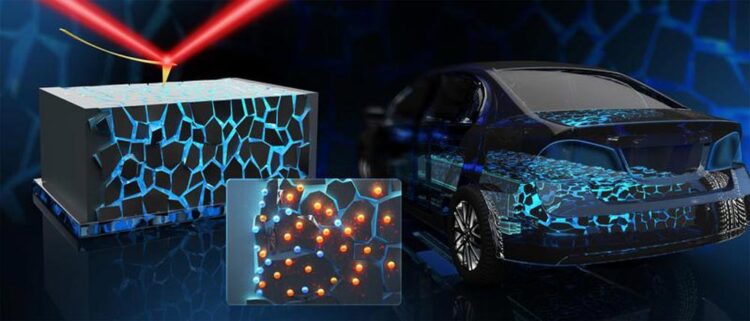Stalactites and stalagmites in the battery?

Solid-state batteries could offer many advantages in the future, including for the use in electrically powered cars
Credit: Xue Zhang / MPI-P
New research could lead to longer-lasting batteries.
Whether in an e-car, cell phone, or cordless screwdriver, many devices used on a daily basis now use rechargeable batteries. However, the trend also has its downsides. For example, certain cell phones were banned from being carried on airplanes, or e-cars caught fire. Modern commercial lithium ion batteries are sensitive to mechanical stress.
So-called “solid-state batteries” could provide a remedy. These no longer contain a liquid core – the so-called electrolyte – but consist entirely of solid material, e.g. ceramics ionic conductor. As a result, they are mechanically robust, non-flammable, easy to miniaturize and insensitive to temperature fluctuations.
But solid-state batteries show their problems after several charging and discharging cycles: While the positive and negative poles of the battery are still electrically separated from each other at the beginning, they are eventually electrically connected to each other by internal battery processes: “Lithium dendrites” slowly grow in the battery. These lithium dendrites grow step by step during each charging process until the two poles are connected. The result: the battery is short circuited and “dies”. So far, however, the exact physical processes that take place in this process are not yet well understood.
A team led by Rüdiger Berger from Hans-Jürgen Butt’s department has now tackled the problem and used a special microscopy method to investigate the processes in more detail. They investigated the question of where the lithium dendrites start to grow. Is it like in a flowstone cave where stalactites grow from the ceiling and stalagmites from the floor until they join in the middle and form a so-called “stalagnate”? There is no top and bottom in a battery – but do dendrites grow from the negative to the positive pole or from the positive to the negative pole? Or do they grow equally from both poles? Or are there special places in the battery that lead to nucleation and then dendritic growth from there?
Rüdiger Berger’s team looked in particular at so-called “grain boundaries” in the ceramic solid electrolyte. These boundaries are formed during the production of the solid layer: The atoms in the crystals of the ceramic are basically very regularly arranged. However, due to small, random fluctuations in crystal growth, line-like structures are formed where the atoms are arranged irregularly – a so-called “grain boundary”.
These grain boundaries are visible with their microscopy method – “Kelvin Probe Force Microscopy” – in which the surface is scanned with a sharp tip. Chao Zhu, a PhD student working with Rüdiger Berger says: “If the solid-state battery is charged, the Kelvin Probe Force Microscopy sees that electrons accumulate along the grain boundaries – especially near the negative pole.” The latter indicates that the grain boundary not only changes the arrangement of the atoms of the ceramics, but also their electronic structure.
Due to the accumulation of electrons – i.e. negative particles – positively charged lithium ions traveling in the solid electrolyte can be reduced into metallic lithium. The result: lithium deposits and lithium dendrites form. If the charging process is repeated, the dendrite will continue to grow until finally the poles of the battery are connected. The formation of such initial stages for dendrite growth was only observed at the negative pole – also observed only at this pole. No growth was observed at the opposite positive pole.
The scientists hope that with a precise understanding of the growth processes, they will also be able to develop effective ways to prevent or at least limit growth at the negative pole, so that in the future the safer lithium solid-state batteries can also be used in broadband applications.
Journal: Nature Communications
DOI: 10.1038/s41467-023-36792-7
Method of Research: Experimental study
Subject of Research: Not applicable
Article Title: Understanding the evolution of lithium dendrites at Li6.25Al0.25La3Zr2O12 grain boundaries via operando microscopy techniques
Article Publication Date: 9-Mar-2023
Media Contact
All latest news from the category: Power and Electrical Engineering
This topic covers issues related to energy generation, conversion, transportation and consumption and how the industry is addressing the challenge of energy efficiency in general.
innovations-report provides in-depth and informative reports and articles on subjects ranging from wind energy, fuel cell technology, solar energy, geothermal energy, petroleum, gas, nuclear engineering, alternative energy and energy efficiency to fusion, hydrogen and superconductor technologies.
Newest articles

High-energy-density aqueous battery based on halogen multi-electron transfer
Traditional non-aqueous lithium-ion batteries have a high energy density, but their safety is compromised due to the flammable organic electrolytes they utilize. Aqueous batteries use water as the solvent for…

First-ever combined heart pump and pig kidney transplant
…gives new hope to patient with terminal illness. Surgeons at NYU Langone Health performed the first-ever combined mechanical heart pump and gene-edited pig kidney transplant surgery in a 54-year-old woman…

Biophysics: Testing how well biomarkers work
LMU researchers have developed a method to determine how reliably target proteins can be labeled using super-resolution fluorescence microscopy. Modern microscopy techniques make it possible to examine the inner workings…





















